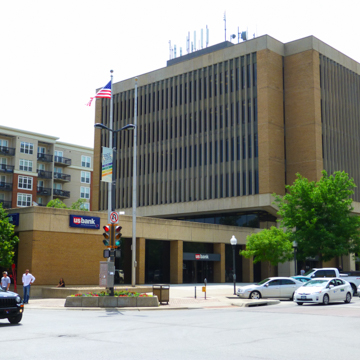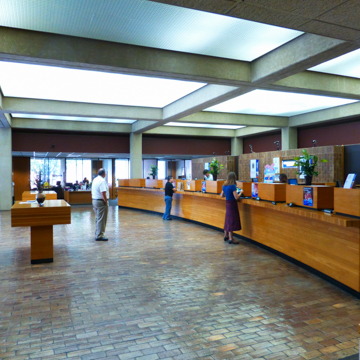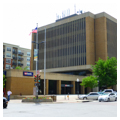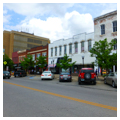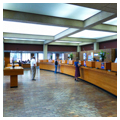You are here
U.S. Bank
The U.S. Bank Building occupies the southeast corner of Ninth and Massachusetts streets, the central spine of Lawrence’s commercial district. The unabashedly modern bank building stands in stark and illuminating contrast to its neighbors lining the six blocks within the downtown historic district, mainly two- and three-story brick commercial buildings erected between the 1850s and the 1930s.
The historic district provides the context to which the U.S. Bank Building must respond in terms of size, scale, street wall, materiality, and iconography. In most ways, the Bank Building relates to this context by contrast. Occupying six building lots and rising seven stories in height, the bank is notably larger than its neighbors. It also has a greater sense of scale: the massive piers that frame deep-set, dark-tinted windows on the base of the building make it seem monumental and foreboding, and the vertical fins that cover all sides of upper four floors obscure all signs of human habitation. The structure’s lack of regard for its setting is also evident in its position on the site. Where the other buildings on Massachusetts Street are pushed to the front of the site, the base of the Bank Building is set back, thereby creating a wider sidewalk and altering the space of the street.
While the U.S. Bank Building does not defer to its neighbors, it adds a strong and timely accent to its surroundings, exemplifying the central tenets of modernism. The clear separation and differentiation of the tall ground level, which houses the building’s public spaces, from the upper private office floors illustrates modernism’s penchant for functional rationalism. Meanwhile, the muscular piers, which lift the office tower above the horizontal ground level, illustrate modernism’s reliance on structural rationalism. The bank’s heavy, bold, and simple massing is also representative of the type of modernism in vogue at its time of construction. It is a building that is strongly connected to its time, if not its place.
The U.S. Bank Building is a fitting representative for its designers, Kivett and Myers, who were among the most ardent and effective proponents of modernism in the region. During the firm’s thirty years of practice, it earned thirty design awards given by the local AIA chapter. Clarence Kivett and Ralph Myers organized the firm to give the young employees exposure to all aspects of architectural practice, and the record of its alumni surpassed even that of the parent firm. Of the forty-six local AIA design awards given in the late 1960s through the mid-1990s, forty were earned by firms whose principals had previously worked at Kivett and Myers.
The building has been home to at least three different banks but remains in its original state.
References
Sachs, David. Space for Architecture: The practice of Kivett and Myers 1945–1976. Kansas City, MO: AIA Kansas City, 1993.
Wolfenbarger, Deon, “Lawrence’s Downtown Historic District,” Douglas County, Kansas. National Register of Historic Places Inventory-Nomination Form, 2004. National Park Service, U.S. Department of the Interior, Washington, D.C.
Writing Credits
If SAH Archipedia has been useful to you, please consider supporting it.
SAH Archipedia tells the story of the United States through its buildings, landscapes, and cities. This freely available resource empowers the public with authoritative knowledge that deepens their understanding and appreciation of the built environment. But the Society of Architectural Historians, which created SAH Archipedia with University of Virginia Press, needs your support to maintain the high-caliber research, writing, photography, cartography, editing, design, and programming that make SAH Archipedia a trusted online resource available to all who value the history of place, heritage tourism, and learning.

